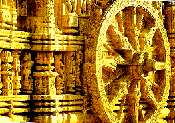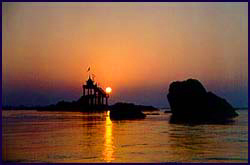| Destinations
|
|||
 Konark is the site of the Konark Temple, cited as one of the best examples of religious architecture in the world. Dedicated to Surya, the Sun God, the temple stands majestically in partial ruins next to Konark beach. An ancient amphitheatre with the Sun Temple as the backdrop is the venue for one of the most exciting dance festivals held in the country.
Konark is the site of the Konark Temple, cited as one of the best examples of religious architecture in the world. Dedicated to Surya, the Sun God, the temple stands majestically in partial ruins next to Konark beach. An ancient amphitheatre with the Sun Temple as the backdrop is the venue for one of the most exciting dance festivals held in the country.
What to see "Here the language of stone surpasses the language of man" ~Rabindra Nath Tagore.
The Sun Temple (Surya Devi) at Konark personifies the temple architecture of Orissa. It stands stark and proud amidst the surrounding sands. It was originally built on the edge of the Ocean, which today has receded to a respectful distance. The temple is often referred to as the Black Pagoda and is a world heritage site.
Built in the thirteenth century by King Narasimhadeva, it is in the shape of a celestial chariot for carrying Surya, the sun god, across the heavens. Seven horses pull the chariot, with twelve wheels on either side. These symbolise the divisions of time. The seven horses representing the number of days in a week and each wheel representing an hour or a fortnight.
|
More About Orissa • An Overview • History • Geography • Culture
Places to Visit
Travelogues
Leisure |
||
 The size of the temple is awe-inspiring. Legend has it that the king was so passionate about its construction that he let it consume 12 years worth of the revenues of the kingdom.
The size of the temple is awe-inspiring. Legend has it that the king was so passionate about its construction that he let it consume 12 years worth of the revenues of the kingdom.
The main tower has now collapsed but was built in the same form as the Jagannath temple at Puri. It towered to 227 feet. The three main images of Surya on three facades are carved in chlorite stone and stand in the formal frontal position often used to portray divinities in a state of spiritual equilibrium The porch structure exceeded 120 feet in height. Below the high platforms of the tower and the porch are the 24 stone wheels. The third major component of the temple complex is the detached natamandira (hall of dance), which remains in front of the temple. Of the 22 subsidiary temples that once stood within the enclosure, two remain the Vaishnava Temple and the Mayadevi Temple. At either side of the main temple are colossal figures of royal elephants and horses. Though the motivation for building the temple is not known, Narasimhadeva, probably constructed it as a victory monument, after a successful campaign against Muslim invaders. The carvings on the temple give an insight into the social environment of royalty in the 13th century. There are wonderfully carved images of hunts, lovers, deities, dancers, birds, animals, and mythological creatures as also other intricate designs. The temple is also famous for its erotic sculptures celebrating the joys of living. The Museum: The Sun Temple Museum run by the Archaeological Survey of India has an excellent collection of sculptures from the temple ruins.
Chandrabhaga beach: Close to the Sun Temple of Konark, is the lovely quiet beach - of Chandrabhaga. The beach is not crowded and one can spend a few quite moments contemplating the beauty of the surroundings. In the month of Magha Saptami (february), the Chandrabhaga Mela, is celebrated with much fanfare. On this day pilgrims come to take a holy dip in the pool and then converge on the beach to watch the sun rise over the sea. Konark Dance Festival: Dance has always been an integral part of worship in Orissa. Nearly all temples in Orissa incorporate a dance hall. Odissi, the traditional classical dance of Orissa owes its revitalisation to the discovery of the ancient treatise on dance, the 'Abhinaya Chandrika' and the study of ancient sculptures on the walls of temples by dedicated artistes. Konark Dance Festival, a mega-celebration of classical dance forms in India, is held in winter every year. Around Konark: Beleswar: 20 kms from Konark, Beleswar is popular for the Saiva shrine and the sea beach. When to visit: Getting there:
Information: Courtesy Government of India |
|||
Editor: Romola Butalia (c) India Travelogue. All rights reserved. |
|||

 Konark beach: Konark beach is calmer than the Puri beach, which tends to get very rough. However, the waters tend to be trickier - even strong swimmers need to be wary. The immense backdrop of the Sun Temple looks breathtaking when illuminated in the evening.
Konark beach: Konark beach is calmer than the Puri beach, which tends to get very rough. However, the waters tend to be trickier - even strong swimmers need to be wary. The immense backdrop of the Sun Temple looks breathtaking when illuminated in the evening.